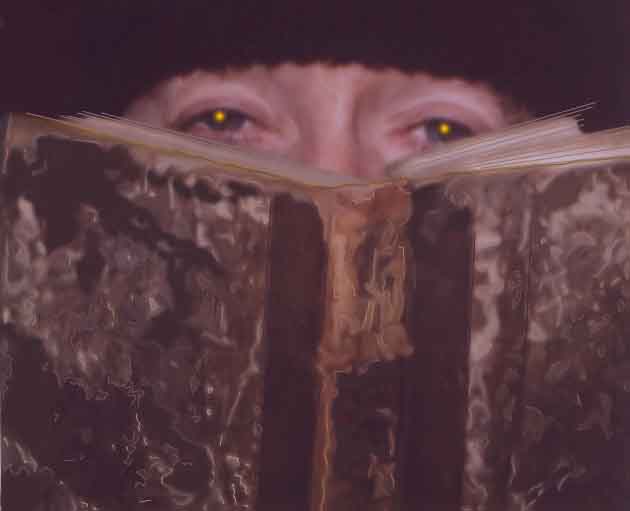









WILLIAM PURA (Der Holzweg: The Way Through the Woods
Site Gallery, Winnipeg)
[First published in Winnipeg's Border Crossings magazine, February 2003, 74-75.]
William Pura turned Winnipeg's Site Gallery into a dark forest. Example: a real buck's head -- antlers and all -- was made into a fountain by means of a mechanism that pushed a continuous steam of water out of the animal's mouth into a galvanized basin below. The head's expression was placid as the spit erupted. This deer was a Source, and the tin receptacle could have stood for industrial consumption.
The retrospective that I had expected from Pura, who is a senior Winnipeg artist, would have included photo-based paintings and his early conceptual/minimalist prints. (The early prints are my favorite Pura works.) Excerpts from fifteen years of art were shown, but because Pura is best known now as a realist painter and musical composer, not a sculptor or installation artist, I was a little puzzled. There may have been a performance and music at the opening, but the art left afterward was not merely a set of props for music -- and painting was absent. In this retrospective, the artist, as befits the artist-run Site Gallery, had been allowed to tease out one strand of his story.
Pura referred to a great number of things in his artist's statement, including Edward Hopper (some of Pura's paintings bear allegiance to Hopper), film noir, Canaletto, Rupert Brook (who visited Canada in 1912, and according to Pura commented on the lack of Canadian myths about the land), and Nordic mythology, which Pura adduced in order to counter " the myth [of] the Canadian wilderness [as] a blank slate."
The work had a pounded-together look, as if it had been made in the woods by a rural craftsman. It reminded me of outback Canada, where a piece of milled wood might hang off a tree at an odd angle, or where one might see paint smeared in an unreasonable patch on the side of a barn. This show felt like nature burying culture under moss, the way the coastal forests in Canada slowly climb over inert, sometimes dead things.
In conversation, it was clear to me that the artist was looking to the European forest to reanimate the Canadian woods by calling up the ghosts of Germania. Pura avoids using Native/First Nations legends and myths, I venture, for polite cultural-copyright-chill reasons, the way so many other non-Native artists do (as if Native themes were owned by a litigious corporation like Disney). And so he has lately looked to Europe for inspiration.
In Pura's forest nature was not at all well, as if the winter had no snow. One of his tree limbs had an eye embedded in it (I expected it to wink at me, but like the glass-eyed deer, it was still.) Another tree trunk had skulls attached, suggesting malevolence -- maybe that Goths had just charged through. A video, housed in a rough box played a tape loop of a sculpted horse head bobbing in murky water. Full-length body prints of male and female figures (Pura and his wife Talia) added yet more ghostly forms to the spooky scene.
Pura's adapted mythologies have sources that antedate Tacitus (c.56-116 AD). Tacitus describes how the primitive forest-dwelling Germans terrified Roman invaders. Until the end of World War II, when the Russians raced through the woods toward Berlin to extinguish Hitler, the evergreen forest has figured importantly in German mythology. The Nazis read Tacitus, of course, (see Simon Schama's "Landscape and Memory") and Nazi ecologists, we remember, wished to extend the German forest, gods included, all the way to Russia. After the War, however, the obsession wore off, and artists such as Joseph Beuys and Anselm Kiefer referred to German forest mythologies with a keen awareness of Nazi perversions.
It is interesting that William Pura wishes to recover German paganism now. Is it because the War has been over for more than 50 years? A contemporary German fascination with Native North American culture and land manifests itself in tourism and the cult of the "hobby Indian." Perhaps Pura is returning the German favour. If German and Canadian forests look so similar, then why shouldn't Canadians and Germans exchange mythologies? This may sound preposterous, but it would be as silly to criticize Pura for an insufficient cleansing of Nazi-tainted Germanic fictions as he attempts to apply old German myths to the Canadian wilderness as it would be to castigate German weekenders for dressing up like Natives. Artists and others feel compelled to "fix" whatever culture they happen to have inherited. That's good, because culture is always broken.

|
|